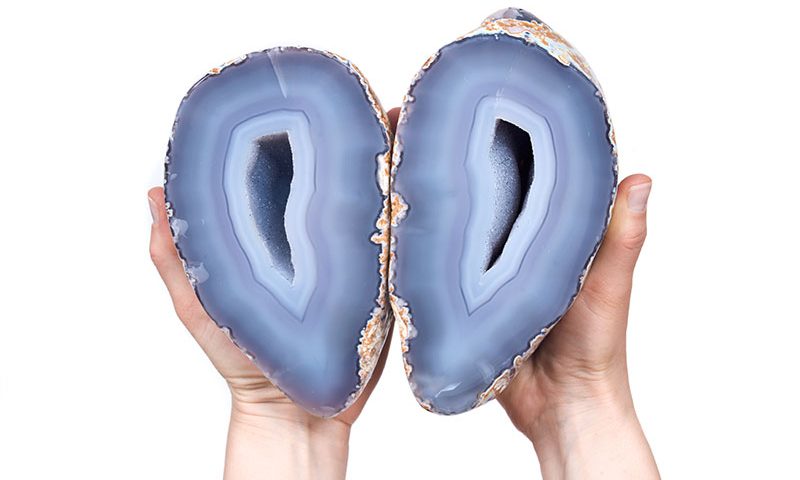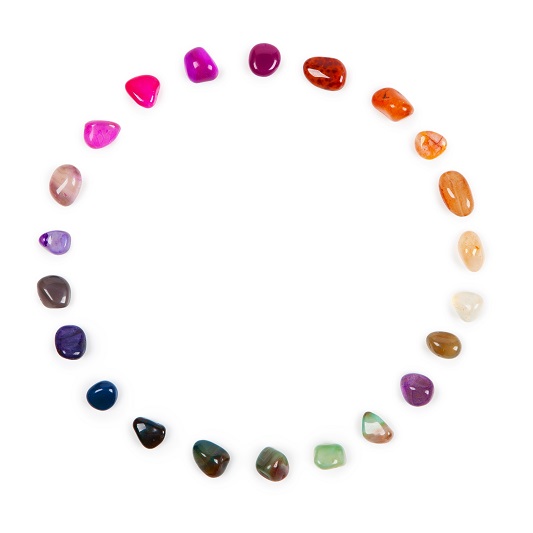Gemstone of the Week: Agate

Gemstone Bracelets: The Power to Heal
7th July 2017
Gemstone of the Week: Turquoise
13th July 2017Possibly one of the most widely found and mined type of gemstone is Agate, with thousands of tonnes of the stone being mined every year for both decorations and use in products such as jewellery.
Agate’s popularity isn’t recent, either. In jewellery expert and author Antoinette Matlins’ Coloured Gemstones Buying Guide, Matlins says, “the unusual colours and markings of agate made it very highly regarded by the ancients and revered throughout history.” She adds, “According to Pliny, it was believed to make wearers ‘agreeable and persuasive and give them God’s favour.” Agate also was and still is a popular ornament. Matlins says, “Wearing agate ornaments was also seen as a cure for insomnia and could ensure good dreams. In the middle of the 1800s, and continuing to the present in some parts of the world, amulets made from eye agate (brown or black agate with a white ring in the centre) were so popular that agate cutters in Germany had time for cutting little else.” Why was the eye symbol so special? “The ‘eye’ was believed to take on the watchfulness of one’s guardian spirit and to protect the wearer from the evil eye by neutralising its power.” In terms of Agate’s financial value, surprisingly, Matlins adds, “at one time these amulets commanded an incredible price.”
Despite its continued popularity for thousands of years, Agate is now a relatively affordable gemstone, with semi-precious bracelets available from fashion retailers for as little as ten pounds, if not less.
In this article, we explore the essential characteristics of Agate, where you find Agate, and the semi-precious stone’s healing properties, including how it can heal both emotionally and physically.
How to Identify Agate
Setting Agate apart from other forms of Chalcedony, or Quartz is Agate’s distinct and attractive banding. While other types of Quartz are plain, Agate is, typically, striped or features aesthetically-pleasing circular patterns often interwoven with variations of colour, such as a palette of translucent or foggy grey, pastel blue and white. Usually, Agate is cut into spherical or oval shapes and used in jewellery, however, in its raw and most natural state, it simply looks like a bumpy striped rock. If the striped pattern on an Agate gemstone is particularly sharp, the cost of the gemstone may increase vastly. Similarly, cheaper Agate is that which has fainter patterns and is, therefore, less aesthetically desirable for decoration. In some cases, patterns will be very faint, and you won’t be able to tell that a stone is Agate until you cut the stone open. As Matlins mentions in her book, as well its use as a cabochon or bead in jewellery, Agate is a precious ornament thought to have healing properties.
Different Colours and Types of Agate
Agate comes in virtually every colour, including everything from white, blue and red to yellow, orange, brown and pink, and most frequently multicoloured. However, some manufacturers whose responsibility it is to cut, clean and polish the stones choose to dye Agate to intensify the colours. Especially if your Agate is from Brazil and is hot pink, blue or green in colour, typically, it will be dyed using synthetic treatments and enhancements so that manufacturers can command a higher price.
As well as being categorised by its banding and separated into different colours, as well as natural and treated, Agate comes in a variety of distinct forms. For instance, Agate Geode is an especially popular choice for decoration and, when cut in half, appears to be a striped multicoloured stone with clusters of crystal Quartz in the centre. Often when you’re travelling in Europe, you will see souvenir shops selling slices of Agate Geode, especially if you’re in places such as Spain, Portugal, and Italy. Other forms Agate comes in includes Blue Lace Agate, which features light blue bands; Eye Agate, which has perfectly rounded concentric rings; Fire Agate similar to Opal in colour; and iridescent Iris Agate.
Where is Agate Found?
Agate is mined all over the world, including in South America, Canada, Russia, Poland, Africa, India, Australia, and the USA, with the largest deposits in Brazil, Argentina, Mexico, and South Dakota.
Some of the most important Agate mines in the world include the Agua Nueva Ranch (Mexico), located around 20-miles northeast of the infamous Laguna agate deposits in Chihuahua, northern Mexico. Other key areas include the Nahe River valley in Germany, where Agate mining dates to the late 15th-century but many mines are now exhausted, as well as numerous mines on the left bank of the Oka River in Russia, around 100m south of the Russian capital of Moscow. Today, the largest percentage of the world’s Agate comes from Brazil, which is home to dozens of vast open pit Agate mines.
Healing Properties of Agate
As with many types of natural gemstones, Agate is thought to help heal mentally, physically, and spiritually. Agate enhances various mental functions, including concentration and perception.
Emotionally, Agate encourages peace and harmony while Agate gemstones with irregular designs may help important decision making. It is also thought to improve self-confidence which, as a result, will encourage you to speak up in situations. Physically, many consume Agate gemstones as elixirs in which, commonly, the stones are rested in water overnight and then the water consumed. By consuming Agate as an elixir, you may be able to improve digestive health, eye health and general organ health, as well as to improve skin blemishes and heal wounds, including small cuts and acne.
If you have a fever, you should place a cold Agate on your forehead to help relieve symptoms.
In Summary
Agate is a powerful gemstone renowned for its use in jewellery and as an ornament. It comes in a variety of colours and is found all over the world. Whether you are looking to settle your digestive system, clear your skin of rashes or blemishes, or improve your emotional health and become more confident, Agate can help. Remember, if you try Agate as a natural remedy for illness and symptoms persist, always arrange an appointment with your doctor or seek reliable, professional health advice.




